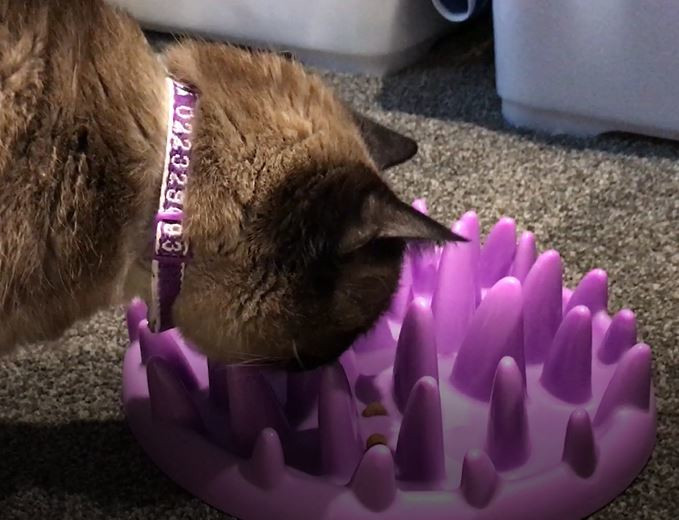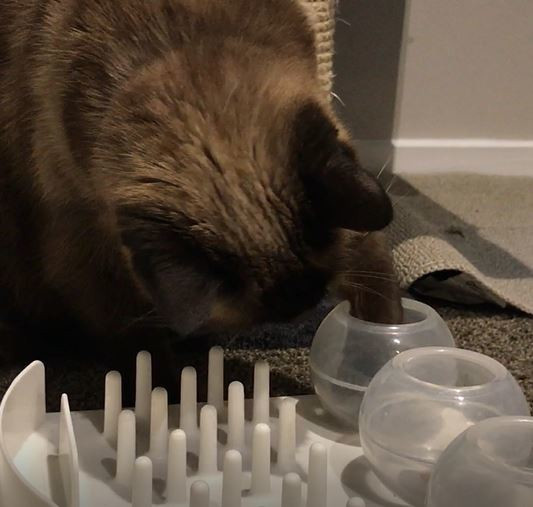Do cats have special nutritional requirements?
Cats have special nutritional requirements because they have some fundamental differences in what and how they can metabolise and utilise different food sources compared to many other animals (such as dogs).
Cats’ special nutritional requirements
Cats have evolved as obligate carnivores, which means they are dependent on the nutrients that would be provided by a diet based on consuming prey animals [1]. This means they cannot be healthy or survive without the specific nutritional components in such a diet (for example, specific amino acids, the essential fatty acid arachidonic acid, and preformed vitamin A) [1]. Cats do need more than just meat alone, and in the wild they would eat their whole prey (the prey animal’s entire body including the meat, organs, and bones). A diet of meat only would be deficient in certain important nutritional elements.
Cats do not have some special enzymes and body processes which other animals have to digest and convert plant nutrients [1, 2]. This means that they cannot utilise plant-based foods in the same way that dogs and many other animals can. Cats also have a higher requirement for protein in their diet compared to dogs and many other animals [1].
Cats should not be fed dog food, as the dietary requirements are very different for the different species.
It is recommended that cats are not fed any raw or dehydrated non-sterilised foods, including treats, that are of animal origin, as the evidence of potential benefits of feeding raw meat are outweighed by the potential health risks [2].
Since cats have very specific nutritional requirements, it is recommended that the basis of a cat’s diet should be a high quality balanced commercial species-appropriate food formulated using sound scientific evidence that is appropriate for their life stage (e.g., kitten, adolescent, adult, pregnant, senior) and health status [2, 3]. By reading the label, you should also check that the food is a nutritionally complete pet food and conforms to the recommended requirements for cats in accordance with an internationally recognised nutritional profile (e.g. AAFCO in the USA or FEDIAF in Europe) [2].
In addition, each cat is an individual and, therefore, you should seek veterinary advice on your cat’s ideal diet; particularly if your cat has any medical problems, special dietary needs, or has a sensitivity to any foods.
There is limited evidence relating to the health impacts of feeding cats a plant-based or vegan diet and the studies that have been performed have tended to have small sample sizes and unreliable study design [4]. Although it is possible to develop a plant-based diet for cats, these need to be carefully formulated to meet the unique nutritional requirements of the cat and be appropriately supplemented with essential nutrients [1]. There is currently no overwhelming evidence of adverse effects arising from use of these diets but, given that there is inadequate evidence to support their use, caution is advised in considering the use of these diets [4]. High quality studies with large sample sizes, standardised outcome measures, and reliable study design are needed. If someone is considering a plant-based or vegan diet for their cat, this should be done cautiously and a commercially produced diet which has been formulated to meet the specific nutritional needs of cats should be used [4].
Different types of food
In most cases, it is good to feed your cat some wet and some dry food, depending on their health and individual requirements. Cats can develop very fixed food preferences, which means that they decide they will only eat one kind of food and refuse everything else [5]! If you can, it is good to try and avoid this happening by feeding them some wet and some dry food from as early as possible so that you have more flexibility to change their diet if needed. Some cats prefer dry food while others prefer wet.
The higher water content in wet food can help improve overall water intake [2]. Some circumstances may make it important to maximise a cat’s water intake (for example, some medical conditions like renal insufficiency or lower urinary tract disease) [2, 5]; in these cases, it may be better to feed the cat wet food based on veterinary advice, along with taking other steps to increase their water intake.
Other tips
Any changes to your cat’s diet should be made gradually over 4 to 7 days to help minimise the chance of any gastrointestinal upsets (unless specifically under the advice of your veterinarian) [3].
Cats should always have multiple sources of fresh clean water freely available. Water and food bowls should be kept clean and washed regularly [2].
If allowed to choose, cats eat 8-16 meals a day [6] and they prefer to eat alone [7]. Therefore, it is recommended that cats are fed little and often, at least 5 meals a day [8] and not near other cats [7]), as this is closer to the way that they would naturally eat. Cats should not be forced to eat close to other cats as this can cause stress and, consequently, health problems [7]. It is best if cats have control over when and where they eat (i.e., multiple feeding stations and the ability to access food when and how they want to rather than relying on humans to give them food at meal times) [9].
Ideally, you should use your cat’s food as a source of enrichment by using food toys and puzzle feeders. This encourages the cat to engage in important foraging and predatory behaviours which are mentally and physically stimulating [7, 10]. Please see the RSPCA’s guide to keeping your cat safe and happy at home for ideas. Offer several types of puzzle feeders in different locations and change them regularly. It is best to start with simpler puzzles and as your cat gets the hang of these, use puzzle feeders with increasing difficulty to provide more challenging stimulation for your cat. Both wet and dry food can be used in puzzle feeders. Advice on how to introduce food toys and puzzles can be found here.

Example puzzle feeder.

Example puzzle feeder.
To help you monitor your cat’s health, it is a good idea to weigh them regularly. Record the weight every week or two and if it is showing a trend of going up or down, talk to your veterinarian. This can help you pick up and address health issues early.
References
Case LP, Daristotle L, Hayek MG, Raasch MF (2011) Nutritional Idiosyncrasies of the Cat. In: Canine and Feline Nutrition. Elsevier, pp 57–58
Quimby J, Gowland S, Carney HC, DePorter T, Plummer P, Westropp J (2021) 2021 AAHA/AAFP Feline Life Stage Guidelines. J Feline Med Surg 23:211–233
Cline MG, Burns KM, Coe JB, Downing R, Durzi T, Murphy M, Parker V (2021) 2021 AAHA Nutrition and Weight Management Guidelines for Dogs and Cats. J Am Anim Hosp Assoc 57:157–178
Domínguez-Oliva A, Mota-Rojas D, Semendric I, Whittaker AL (2023) The Impact of Vegan Diets on Indicators of Health in Dogs and Cats: A Systematic Review. Vet Sci 10:52
Case LP, Daristotle L, Hayek MG, Raasch MF (2011) Types of Pet Foods. In: Canine and Feline Nutrition. Elsevier, pp 163–176
Delgado M, Dantas LMS (2020) Feeding Cats for Optimal Mental and Behavioral Well-Being. Veterinary Clinics of North America – Small Animal Practice 50:939–953
Sadek T, Hamper B, Horwitz D, Rodan I, Rowe E, Sundahl E (2018) Feline Feeding Programs: Addressing behavioral needs to improve feline health and wellbeing. J Feline Med Surg 20:1049–1055
Ellis S, Rowe L (2019) Five-a-Day Felix – A report into improving the health and welfare of the UK’s domestic cats. Accessed 8 Mar 2023
Ellis SLH, Rodan I, Carney HC, Heath S, Rochlitz I, Shearburn LD, Sundahl E, Westropp JL (2013) AAFP and ISFM Feline Environmental Needs Guidelines. J Feline Med Surg 15:219–230
Dantas LMS, Delgado MM, Johnson I, Buffington CT (2016) Food puzzles for cats: Feeding for physical and emotional wellbeing. J Feline Med Surg 18:723–732
Was this article helpful?
This work is licensed under a Creative Commons Attribution-NonCommercial-NoDerivatives 4.0 International License.


